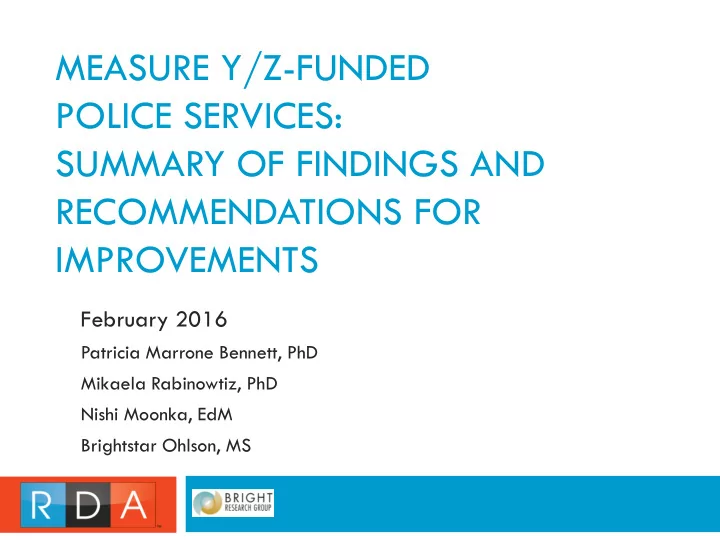

MEASURE Y/Z-FUNDED POLICE SERVICES: SUMMARY OF FINDINGS AND RECOMMENDATIONS FOR IMPROVEMENTS February 2016 Patricia Marrone Bennett, PhD Mikaela Rabinowtiz, PhD Nishi Moonka, EdM Brightstar Ohlson, MS
Agenda 2 Evaluation Overview • Evaluation Background • Current Evaluation Activities Measure Y to Measure Z • Legislative changes Evaluation Findings & Recommendations • Strategic Vision and Leadership • Data & Learning Infrastructure • Measure Y/Z Funded Services Questions and Answers
Evaluation Overview 3 Evaluation Background Current Evaluation Activities Community Policing Evaluation
Community Policing Evaluation Overview 4 Since 2008, the evaluation team targeted different issues/topics at different points in time. The past two years have focused on quality of problem-solving and community partnership. Types of Evaluation Activities SARA Audits Community Problem partnership solving CRT/PSO Surveys Ridealongs/ Interviews Crime/Personnel data NCPC and Community Surveys Organizational Best Practice/ Literature Review transformation
Current Evaluation Focus 5 How has How has policing evolved over the course of OPD’s role Measure Y? How have the roles of PSOs & CRTs in the City’s changes? violence prevention How will policing shift under Measure Z? What is initiative the Department’s vision of community policing changed under Measure Z? over time? What are the roles of CROs, CRTs, & CeaseFire under Measure Z?
Current Evaluation Activities and Timeline 6
Measure Y to Measure Z 7
Measure Z: A New Framework for Police Services 8 Measure Z • Does not explicitly mandate "community policing," giving OPD more flexibility around how to interpret the legislation and associated activities. • Replaces Problem Solving Officers with Community Resource Officers. • Provides OPD with greater flexibility around how it uses its funds in terms of staffing. • Provides the police with greater flexibility around deployment of Measure Z-funded officers and less guidance around required activities. • Adds funding for Ceasefire Project Management and Data Analysis functions.
Framework for Community Policing 9 A Challenging Balance Problem Enforcement Solving Community Rule of Law Engagement Relationship Suppression Building
Findings and Recommendations 10 Strategic Vision and Leadership • Data and Learning Infrastructure • Implementation of Measure Z-funded Services •
Strategic Vision and Leadership: Findings 11 Finding 1 Finding 2 Finding 3 • While the • There are a number • The Department has Department has of external factors established and commitment to the that impact the promoted clear core tenets of successful visions of procedural community policing, implementation of justice and Measure Z no longer Measure Z funded CeaseFire. legislatively efforts • By contrast, the mandates community • Staffing and other evaluation found a policing. resourcing lack of a consistent shortages vision regarding the role of Community • Inconsistent Resource Officers directives from and Crime Reduction various leaders Teams across the • Frequent changes Department. in Department staffing and leadership.
Strategic Vision and Leadership: Recommendations 12 Develop • Develop a comprehensive plan for community policing that integrates Measure Z funded Comprehensive strategies and other OPD and City. Community Policing • Identify or establish a body to ensure the City is Plan adhering to its community policing mandate. Create • Develop a more robust communications strategy to Communication communicate organizational priorities and strategic directions both internally and externally. Strategy • Develop a more coherent strategy around CRO and Establish a Coherent CRT investments (articulating objectives, priorities, Strategy for CRO and and accountability standards) CRT investments • Communicate that strategy internally and externally.
Data & Learning Infrastructure: Findings 13 Finding 4 : Finding 5 : • The Department collects • There are a lack of established extensive data for compliance accountability metrics and purposes, and has made related data collection and progress in using the SARANet analysis processes for most system and using crime data on Measure Z-funded police crime to inform area and services. Department wide priorities. • However, the Department has limited infrastructure or process for using data for performance management and learning purposes.
Data & Learning Infrastructure: Recommendations 14 Collect and • Ensure that the infrastructure (i.e. data collection review data methods), standards, and practices are in place regularly to to continuously improve the efficacy and efficiency of Measure Z-supported investments. refine approach Regular • Measure Z Oversight should regularly request Oversight of reports of CeaseFire, CRT, and CRO activities and outputs to determine whether current Activities and resource allocation furthers Measure Z goals and objectives. Outputs
Measure Z-funded Services: Findings 15 • Measure Z supports both violence suppression and problem solving strategies through its CeaseFire, CRT and CRO investments. While all have significant potential for improving public safety, organizational, resource and implementation challenges limit their Finding 6: impact. • In addition, violence suppression strategies lead to disproportionate contact between African American residents and police, a real cost that must be considered.
Measure Z-funded Services: Recommendations 16 Ensure CeaseFire • Ensure availability of all CeaseFire services to Clients Can Access participating clients and develop on long-term strategies for moving participants into sustainable employment Services • Increase sustainability of procedural justice by building Increase Procedural procedural justice into officer supervision, review, and Justice Sustainability promotion processes. Establish structures and processes for officers to address trauma on the job. Share and Implement • The Department is currently examining how law enforcement techniques employed by CRTs contribute to Results from disproportionate contact between African American Disproportionate residents and the police. The results should be used to Contact Study assess and change practices. • Update the Department’s standards of practice for CROs Update CRO Standards and determine how much of CRO time should be dedicated of Practice to problem solving. Increase venues for residents to engage, provide feedback, and partner with police.
Questions? 19 Patricia Marrone Bennett, PhD pbennett@resourcedevelopment.net 510.488.4345 x105 Nishi Moonka, EdM nmoonka@resourcedevelopment.net 510.488.4345 x103 Brightstar Ohlson, MS bohlson@brightresearchgroup.com 510.238.9945 x1
Recommend
More recommend